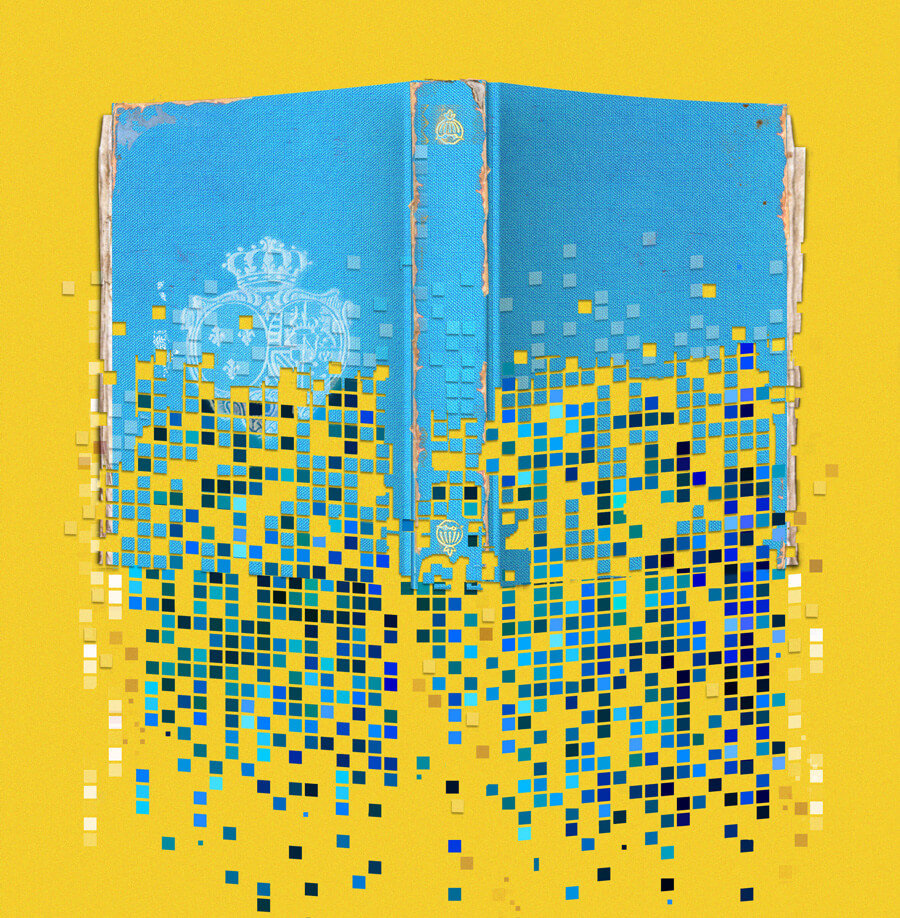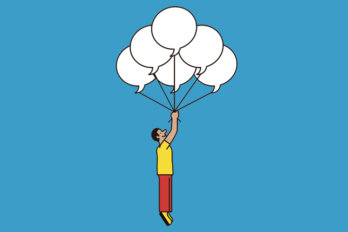Librarians don’t typically cry at work. Their stoic presence at the information desk is supposed to be a bulwark of authority in an age of information overload and questionable online truths. But, once in a while, Jennifer Toews can’t suppress the tears, even when she knows precisely what will trigger them. They typically come when a visitor to the University of Toronto’s Thomas Fisher Rare Book Library, where Toews has worked for nearly two decades, asks to see the papers of Frederick Banting, the U of T doctor who played a key role in the discovery of insulin.
“People come from all over the world to see our material,” Toews says, sitting in a brightly lit office on the ground floor of the library. “They never stop being excited about holding it in their hands.” The library is a multi-storey brutalist concrete silo, the walls and cellars of which are filled with approximately 740,000 rare books and four kilometres of manuscripts, if they were lined up down the street, including such prized items as a copy of Shakespeare’s first folio, a manuscript written by Galileo, and the collected papers of Leonard Cohen. But few items elicit the emotional reaction of Banting’s work.
Most of the visitors seeking out Banting’s papers are doctors. “They want to see how he created an emotional and personal connection with the patients he treated,” Toews says. But, every now and then, a diabetic patient comes to see Banting’s work. The collection includes letters, research papers, sketches, and even a crude drawing of a pancreas on Buckingham Palace stationary that Banting drew for King George V during a lunch in 1934.
“People burst into tears when they see this stuff,” Toews says. “And it makes me cry sometimes too.” A memorable example for her: a ten-year-old public advocate for diabetes patients who came in and read every word of the correspondence between Elizabeth Hughes and her mother. In 1922, Hughes, the teenage daughter of the US secretary of state, was one of the first patients to be treated by Banting. Prior to arriving in Toronto, she had been put on a starvation diet and had withered away in front of her parents’ eyes. “I know you will be surprised when I tell you that I’m actually growing up as well as out,” her letter to “Mumsey” on October 1, 1922, reads, noting her weight and height gain from a short period of insulin treatment. “Dr. Banting’s pleased to death over it, and as I once said, I’m his best patient so far.” Hughes then spends much of the next page gleefully detailing how much she ate for breakfast, including shredded wheat and cream.
Unlike the young visitor whose own tears brought on Toews’s, I didn’t find or read Hughes’s letters in the stacks of the library or hold the pages in my hand under the lamp of its cathedral-like reading room. I pulled them up on my laptop with a quick Google search and clicked through a few of the letters until I found a passage good enough to quote. I did this while sitting in my sweatpants in my house, a half-hour walk from the library.
This seamless, simple, and cost-free access to information has been the dream of librarians, researchers, and curious minds since people began preserving human knowledge in central places. And now, in many ways, that collective goal of civilization has pretty much arrived. Thanks to more than half a century of computer technology, the seeming limitlessness of the internet, and the constant increase in data-storage capabilities with remote access (cloud computing), we can not only preserve infinite things but also preserve them for infinity. This ability goes beyond precious and historically important works to the everyday personal bits and bytes of our lives: notes, emails, family photographs live on a series of anonymous server racks, in an air-conditioned warehouse, in whatever mystery location Dropbox and Google have chosen to domicile them. But digital storage is fallible. Every computer and hard drive can be remotely hacked, infected with destructive viruses, erased by electrical surges, or just fail for reasons that cannot be remedied.
While this digital preservation seems assured, and ridiculously cheap, it comes at an unseen cost in effort, in energy, and in dollars. Removing things from the tactile physical world to the virtual folders I cannot see or hold in my hands also comes at a cost in privacy. The relationship we have to the information that institutions such as libraries care for on our behalf is one we take for granted, but it is more tenuous than we realize. And as we push to preserve, we stand to lose the intimate connection that lies at the heart of research.
Toews is a third-generation librarian. Her mother and grandfather were public librarians in Saskatchewan, and she grew up in the stacks. “I loved everything about libraries,” she says. The library’s singular ability to house endless possibilities in its walls and its mandate to keep those possibilities open to everyone, free of charge, drew her to become a librarian.
These factors remain the mission of libraries everywhere, from the small library in my daughter’s elementary school to the Thomas Fisher Library. Toews’s mission, along with that of her colleagues, is to acquire and preserve information in order to make it accessible. Without preservation, there is no access, but archiving doesn’t happen automatically. With digitization comes the belief that we can preserve everything in perpetuity, but while computer technology makes some elements of dissemination easier (scans can be viewed and indexed on databases accessible from anywhere), each step to preserve a work is an act that demands sacrifice. The truth is that all information will die, regardless of the format.
In the library office, which features a collection of phrenology busts along one shelf and rare, priceless books and papers everywhere you turn, Toews picks up a book that is covered in white vellum. It is a collection of work by the Greek philosopher Aristotle, called De Animalibus, published in Venice in 1498. The book found its way through centuries of owners and was acquired for a small fortune for the library’s collection. “As it is, this will last a really long time,” she says, rubbing her palms over the smooth calfskin, which looks to be in better shape than the covers of some of the books I read to my children each night. “If it is kept safe from pests, fire, and flood, who knows how long it can last?” Toews notes that the items in the library’s collection, including this book, aren’t museum pieces to be kept behind glass. They are research items, available to be read, inspected, and pored over in the search for something greater. “Our mandate is for stuff to be used,” she says.
Physical use leads to physical degradation, and the principal goal of preservation is to head this off. Nearby, in a workshop stacked with thousands of old bookbinding tools, glass vials of hand-mixed natural solutions, and all sorts of presses and machines that would fit right into Gutenberg’s shop, conservator Linda Joy performs the intricate, daily task of keeping the works alive. Her most used tool, she says, is a piece of polished whale bone shaped like a tongue depressor (called a bone folder, to be precise), which she uses to delicately flip, unfold, and crease paper. With this exacting care, and stored in a temperature-, light-, and humidity-controlled environment, a book like De Animalibus can last hundreds of years or longer.
The hope is that, when digitized, these works can live eternally. Once it is codified into ones and zeros, information should theoretically remain consistent in perpetuity, which is why libraries and other institutions (companies, governments, families scanning Dad’s old Super 8 movies) are in a race to digitize before it is too late. But digital preservation is a moving goalpost. The language of binary code may remain static, but the formats we use to store that code are constantly changing, and the pace of change accelerates faster each year. Toews points to a battered shopping bag with a twenty-year-old laptop, which contains a history professor’s database of old Soviet film archives. The computer was getting old, and IT specialists had been called in to copy the hard drive.
“We are always scrambling to fix things,” Toews says of digital archives, which require vigilant maintenance and migration to new formats and standards. Other libraries have faced similar problems. Last April, an article in IEEE Spectrum, a magazine published by the Institute of Electrical and Electronics Engineers, detailed how the loss rates of film archives are increasing quickly, and the technology needed to save the film can’t keep up. It has been estimated that the format chosen to store films, linear tape-open (think big digital videotape reels), needs to be replaced by a new tech generation every seven years, on average. Similarly, research suggests that non-digital videotapes aren’t expected to survive the next twenty years, leading to a crisis of preservation for anything stored in that format. Data on floppy disks, magnetic reels of tape, old hard drives, and flash drives are vastly more fragile than a book bound six centuries ago.
And while there are ongoing costs with a library, of course, for staffing, utilities, and the materials used to preserve collections, digital storage is a service that requires daily feeding of dollars to stay alive. Those dollars are neither infinite nor without their prejudice. Unless a library owns and operates its own servers and stores all its digital information in computers it owns (a costly endeavour that requires massive capital upkeep), the library’s information is at the whim of for-profit corporations. These companies’ interest in preservation goes as far as their bottom line.
The price of digital processers and computer memory continues to decline, on average, but that of digital storage for archiving purposes may not. In a 2012 paper, Stanford digital preservationist David Rosenthal, along with a panel of experts, raised the alarm that long-term digital cloud storage will likely become less economical over time. “Paper as the medium for the world’s memory has one great advantage,” Rosenthal wrote. “[I]t survives benign neglect well. Bits, on the other hand, need continual care, and thus a continual flow of money.”
Then there is the dirty truth of digitization, which is that, in many cases, it can actually aid in the destruction of physical information. To be scanned well, pages need to be flat and free of creases. “You can do fifty years of damage by opening up a text the wrong way,” says Toews. “We always want to save things, but it’s part of our business to know we can’t save everything.”
Not everything wants to be preserved, or digitized, or shared with the widest possible audience. Sometimes, it is for reasons of fragility and value, but other times, it is that information is best restricted to its analog format. When Leonard Cohen donated a collection of papers in 2003 to the Thomas Fisher library, he was adamant that none of the contents should be digitized. If you want to see Cohen’s writing, you have to travel there, request boxes of papers, and flip through the letters and worn notebooks, written in Montreal, Greece, and on the road, one by one.
That may seem archaic and slow, and it is surely less efficient, from a time perspective, than a Google search. But it also is a process of discovery that leads the researcher to unexpected and revealing places. It requires more effort but may lead to more learning. It slows down the process of information absorption and encourages a connection between the text, document, and reader. That can lead to greater insights or even a subtle sense of one letter’s context among many. In the case of the diabetic child reading the letters in Banting’s collection, this process can bring forth unexpected tears that make those sitting nearby cry as well. Unlike the young lady reading those letters, I didn’t cry when I read them online. They were just one more thing flashing on my screen, called up and dispatched with no more effort than scrolling through Facebook. It was not a discovery, nor a journey, but another quick search by an algorithm. I felt nothing.
Information is many things. It is dates and facts and images and words and numbers. But all of those were created to capture something about the human experience, and the reason we seek out and work to preserve information is to deepen our understanding of that experience and where we fit into it, as if we were a single sentence inside a vast library.





